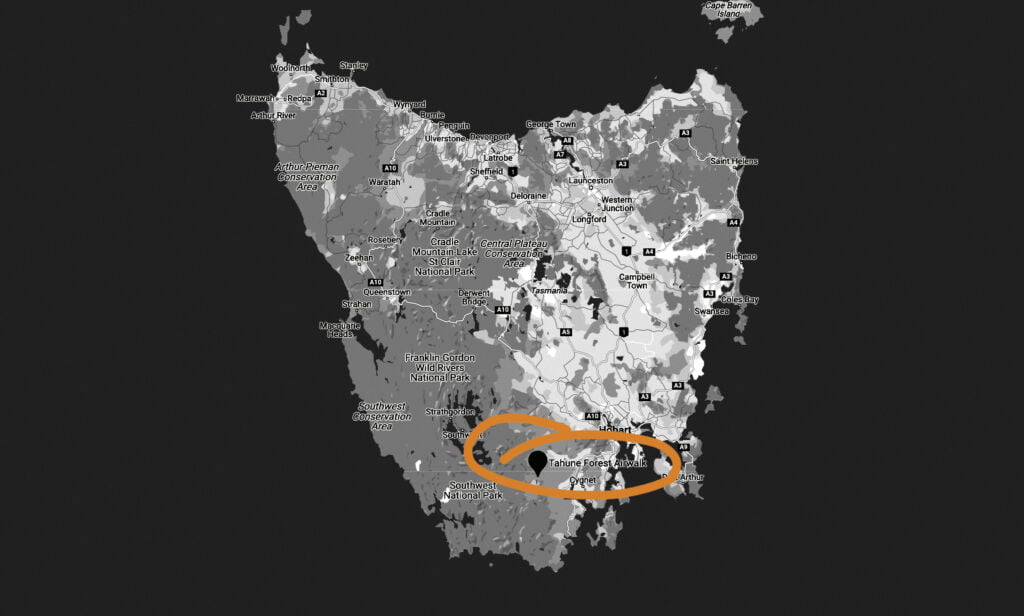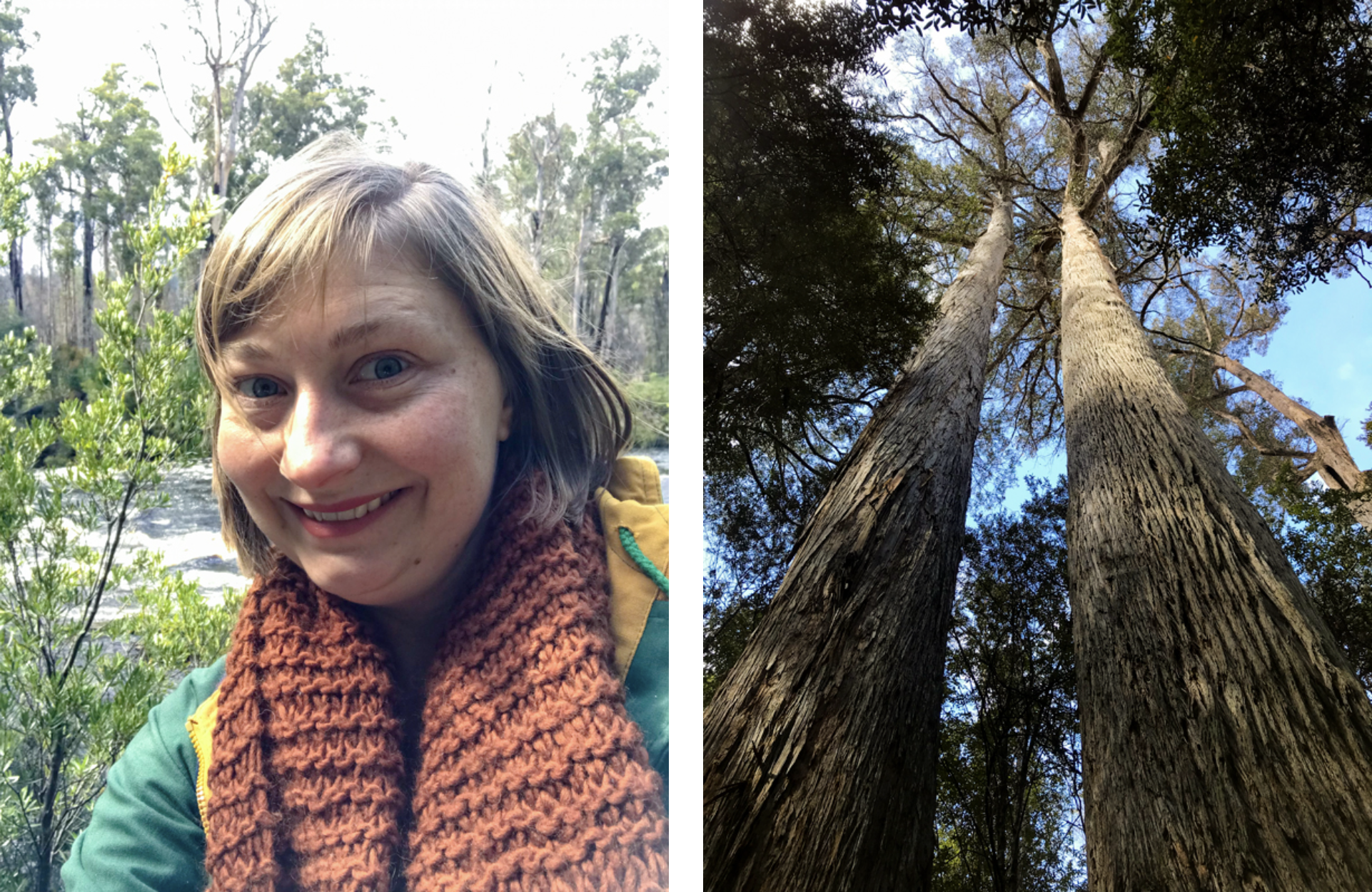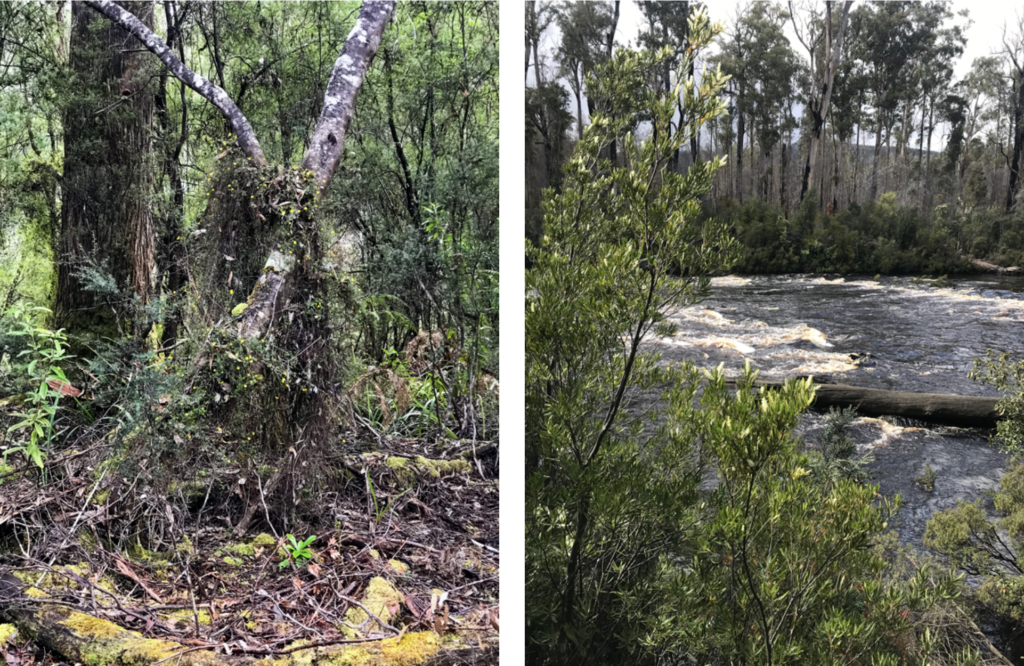Sustainably Managed Forests are the go-to for paper production in the eyes of graphic designers. We know that by selecting the wrong paper when we are quoting we could potentially be responsible for the felling of old growth forests! We certainly don’t want blood leaves <?> on our hands!
Last October one of the graphic designers from the Fresco Creative studio, Andrea, went on a trip to see some of Australia’s old growth forests in Tahune National Park, Tasmania. Located 1.5hrs from Hobart and 35 minutes drive along a wild bush trail once you get to the town of Geeveston, the riverine rainforest growing along the Huon and Picton rivers contained young and (very) mature Huon Pine trees. The Tahune National Park sits just outside the “Southwest National Park” section of the Tasmanian Wilderness World Heritage Area (established in 1982).


Old growth forests are mature forests where the effects of any previous disturbance is now almost non-existant. They are ecologically important because they provide a very broad range of habitats due to the a range of tree sizes, large logs, deomposition, moss and trees with hollows. Their aesthetic and cultural values are recognised as being important to the Tasmanian community and they release vast amounts of oxygen into the atmosphere and absorb CO2. The sequestered carbon dioxide is stored in live woody tissues and slowly decomposing organic matter in litter and soil. If disturbed, the carbon dioxide moves back into the atmosphere. This is why it’s really important to choose the right paper!
The good news is, that of the 1.2 million hectares of forests classified as old growth in Tasmania, 85 per cent – or over one million hectares – is permanently protected in reserves.
Andrea learned that progress in protecting old growth forests in the area has been slow but gains are being made. Since 2016/17, Sustainable Timber Tasmania has not clearfell any coupes containing more than 25 per cent old growth.
She was also very impressed to learn that two giant trees in the region were around 100m tall.
Centurion, the taller of the two at 100.7m, is classified as the World’s Tallest Tree and it’s location is shielded from public knowledge. Icarus Dream, clocking in at 97m, was located to the north, outside the National Park boundary but was being monitored and protected by Sustainable Timber Tasmania.


Certification schemes
While there are several forest certification schemes around the world, the two major ones are the Programme for the Endorsement of Forest Certification (PEFC) and the Forest Stewardship Council (FSC®).
Both certification schemes are notfor-profit and have an international governing body that sets policy and authorises the use of regionspecific standards. Assessment against the established criteria and indicators for these schemes is not carried out by the certification organisation, but by authorised independent auditing bodies. Certification schemes are voluntary and marketbased.


Certification allows the certificate holder to make sustainability claims in the marketplace. This enables purchasers to make well-informed decisions about the products they purchase, taking into account their sustainability standards they expect. The PEFC and FSC scheme logos both have broad international recognition and are seen on wood and paper-based products in many retail outlets.
“The life cycle of Paper
The foundation of a sustainable paper cycle is the use of wood from sustainably managed forests, where after trees are felled they are replaced with seedlings that eventually grow into mature trees, ensuring that the forest is constantly renewed. Such carefully and skilfully managed forests can ensure that tree growth exceeds the rate of extraction, enhances the long-term storage of carbon, and protects biodiversity to maintain forest health. And it of course provides a source of renewable raw material. 100% of the virgin wood fibre we use in our products meets the criteria for wood from sustainably managed forests.
1. Pulp production
Pulping is the process of breaking down solid wood into the individual cellulose fibres that will be used to make paper. Different types of paper require different types of pulp. Fresh pulp (sometimes called Virgin pulp) is produced from pulp wood in one of two basic ways. The first is by mechanical grinding of pulpwood to produce mechanical pulp. This sort of pulp is used mainly for papers which have a short life span such as catalogue papers and newspapers. The second is by cooking the wood with chemicals to dissolve the material which binds fibres together in wood. This produces chemical pulp, usually referred to as Wood Free pulp. This type of pulp is normally used for papers with a longer life span, such as office papers and high-quality marketing material. At UPM we produce and use both mechanical and chemical virgin pulp.
2. Energy generation
Energy is an essential resource for paper mills which use electrical and thermal energy in their production processes. But the industry is also one of the largest generators of renewable and biomass-based energy. By-products from pulp production and from the papermaking process are used to generate CO2 neutral energy in highly efficient combined heat and power plants, which are normally fully integrated with the paper mill. Due to UPMs high energy self-sufficiency, we have been able to take significant steps to reduce the carbon footprint of our mills and production. Our combined heat and power (CHP) plants use renewable fuels such as bark, forest and fibre residues and solid residues from deinking and effluent treatment plants.
3. Paper production
The basic principles of papermaking have remained almost unchanged for two thousand years. Fibres are distributed evenly in water and the water is drained, leaving the fibres bonded together. Today, we utilise the most advanced technology, not only to make paper, but also to ensure that the process utilises raw materials in the most sustainable way, with minimal impact on the environment at every stage from resources to recycling. Papermaking today requires more technology than a jumbo jet. The paper machine is as wide as a two-lane highway and operates 24 hours a day, seven days a week, almost all year long. The three main resources used in papermaking are water, energy and cellulose fibres. Sustainably managed forests provide the cellulose fibres. Lakes and rivers provide the water. Much of the energy used is generated from by-products and side-streams created by the pulp and papermaking processes themselves.
4. Printing and converting
Printing and converting are important stages in the paper life cycle because they can influence how easily a product can be recycled after use. Printing and converting processes can change the characteristics of the paper in a way which may then hinder their recycling. For instance, the use of water-based inks, and extensive use of foil printing, or laminates.
5. Consumer
The reader plays a crucial role in maintaining a sustainable paper cycle, because without their conscientious actions after use, paper would never be recycled.
6. Collection and sorting
One basic rule in using recovered paper is that you can only make a high-quality product from high quality raw material. So if you want to recycle used paper into graphic papers, then you need to sort out the higher quality use paper from lower quality packaging. Only light-coloured recovered papers (newsprint, magazines, advertising materials) are suitable as a raw material for our graphic paper products. Collection and sorting of used paper is also needed in order to remove and separate other valuable recyclable materials such as glass, metals and plastic.
7. Recycling and deinking
Recovered paper needs to be de-inked before the cellulose fibres in it can be reused in papermaking. This process needs some chemicals and a certain amount of energy and water, and removes the inks, fillers and coatings from the paper to leave clean fibres. The by-product resulting from this process can be used as a fuel to generate energy for the mill, and in many cases the fillers and coating removed find reuse in the cement or construction industry, or even back in the papermaking process itself. It’s important to remember that some cellulose fibres are also lost during the deinking process and so the use of virgin fibres will always be necessary to maintain the paper cycle.”
UPM Biofore
If you are searching for a Sydney-based graphic design agency (that will choose the ‘good’ paper stock for you) you can just ask us for a quick quote! Contact us today at Fresco Creative to talk with one of our experienced graphic designers.
